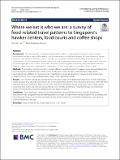| dc.contributor.author | Tan, Shin Bin | |
| dc.contributor.author | Arcaya, Mariana Clair | |
| dc.date.accessioned | 2020-10-30T20:12:27Z | |
| dc.date.available | 2020-10-30T20:12:27Z | |
| dc.date.issued | 2020-10 | |
| dc.date.submitted | 2020-04 | |
| dc.identifier.issn | 1479-5868 | |
| dc.identifier.uri | https://hdl.handle.net/1721.1/128278 | |
| dc.description.abstract | Background
The development of empirically-grounded policies to change the obesogenic nature of urban environment has been impeded by limited, inconclusive evidence of the link between food environments, dietary behaviors, and health-related outcomes, in part due to inconsistent methods of classifying and analyzing food environments. This study explores how individual and built environment characteristics may be associated with how far and long people travel to food venues,that can serve as a starting point for further policy-oriented research to develop a more nuanced, context-specific delineations of ‘food environments’ in an urban Asian context.
Methods
Five hundred twenty nine diners in eight different neighborhoods in Singapore were surveyed about how far and long they travelled to their meal venues, and by what mode. We then examined how respondents’ food-related travel differed by socioeconomic characteristics, as well as objectively-measured built environment characteristics at travel origin and destination, using linear regression models.
Results
Low-income individuals expended more time traveling to meal destinations than high-income individuals, largely because they utilized slower modes like walking rather than driving. Those travelling from areas with high food outlet density travelled shorter distances and times than those from food-sparse areas, while those seeking meals away from their home and work anchor points had lower thresholds for travel. Respondents also travelled longer distances to food-dense locations, compared to food-sparse locations.
Conclusion
Those seeking to improve food environments of poor individuals should consider studying an intervention radius pegged to typical walking distances, or ways to improve their transport options as a starting point. Policy-focused research on food environments should also be sensitive to locational characteristics, such as food outlet densities and land use. | en_US |
| dc.publisher | Springer Science and Business Media LLC | en_US |
| dc.relation.isversionof | http://dx.doi.org/10.1186/s12966-020-01031-5 | en_US |
| dc.rights | Creative Commons Attribution | en_US |
| dc.rights.uri | https://creativecommons.org/licenses/by/4.0/ | en_US |
| dc.source | BioMed Central | en_US |
| dc.title | Where we eat is who we are: a survey of food-related travel patterns to Singapore’s hawker centers, food courts and coffee shops | en_US |
| dc.type | Article | en_US |
| dc.identifier.citation | Tan, Shin Bin and Mariana Arcaya. "Where we eat is who we are: a survey of food-related travel patterns to Singapore’s hawker centers, food courts and coffee shops." International Journal of Behavioral Nutrition and Physical Activity 17, 1 (October 2020):132 © 2020 The Author(s) | en_US |
| dc.contributor.department | Massachusetts Institute of Technology. Department of Urban Studies and Planning | en_US |
| dc.relation.journal | International Journal of Behavioral Nutrition and Physical Activity | en_US |
| dc.eprint.version | Final published version | en_US |
| dc.type.uri | http://purl.org/eprint/type/JournalArticle | en_US |
| eprint.status | http://purl.org/eprint/status/PeerReviewed | en_US |
| dc.date.updated | 2020-10-25T04:16:51Z | |
| dc.language.rfc3066 | en | |
| dc.rights.holder | The Author(s) | |
| dspace.date.submission | 2020-10-25T04:16:51Z | |
| mit.journal.volume | 17 | en_US |
| mit.journal.issue | 1 | en_US |
| mit.license | PUBLISHER_CC | |
| mit.metadata.status | Complete | |
